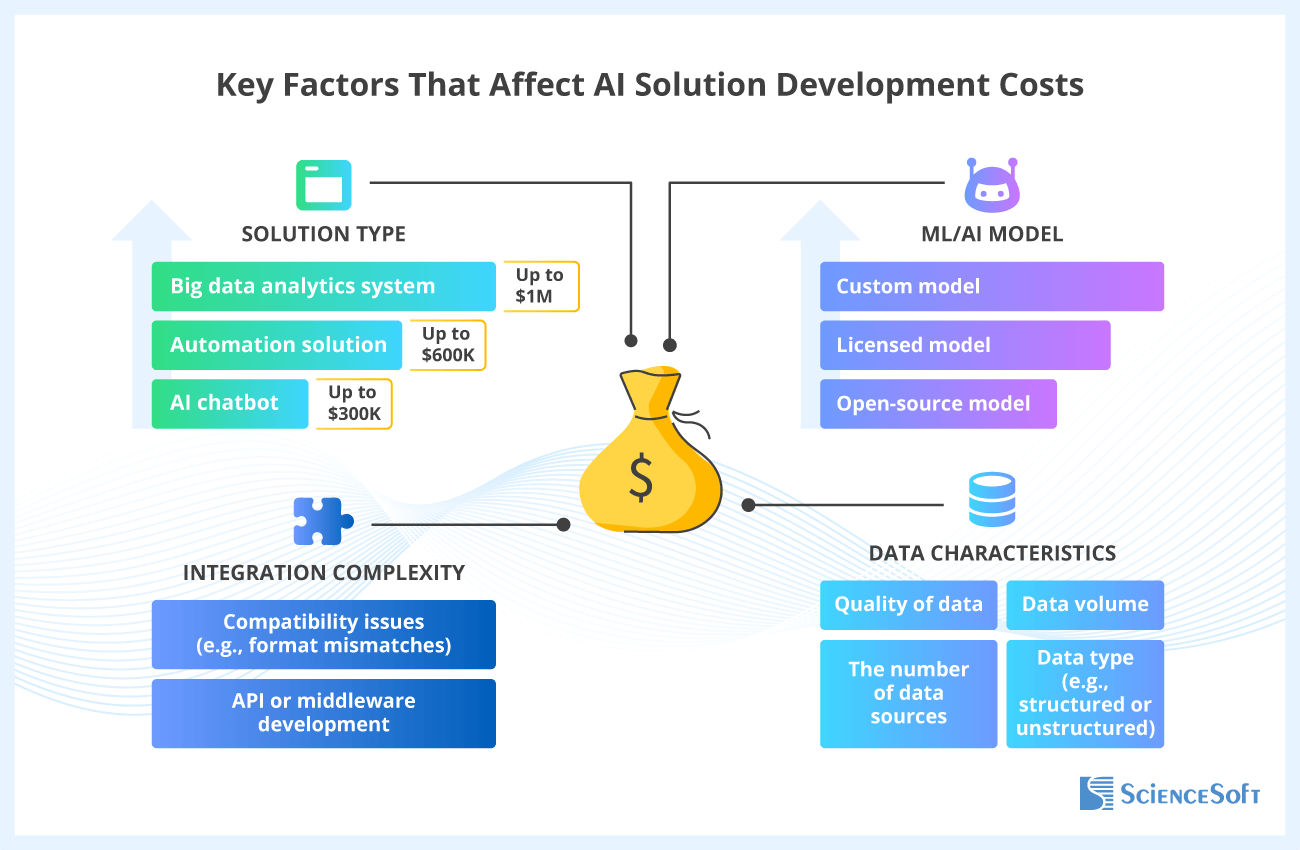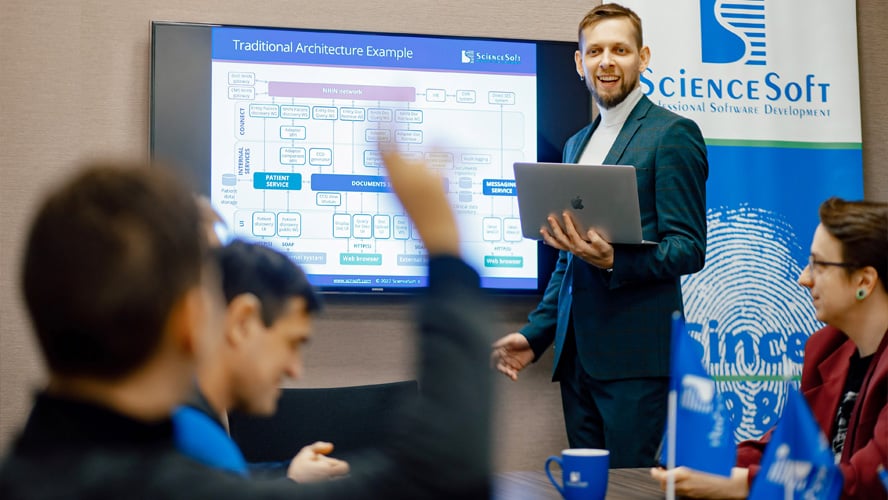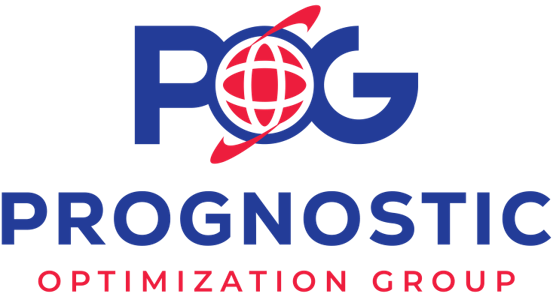We can conceptualize your AI software, help select fitting ML models, and propose a scalable, high-performing solution architecture. Our experts advise on tech stack selection, development planning, TCO reduction, model training, regulatory compliance, and much more.
AI Software Development Services
A pioneer in AI development since 1989, ScienceSoft builds custom AI solutions from simple chatbots and web scraping tools to complex business automation systems. We also help select, develop, train, and maintain machine learning models.
AI development services help get ML-powered solutions that automate repetitive tasks, instantly process large amounts of data and deliver insights, generate content and visuals, and more.
According to a report by Grand View Research, the worldwide artificial intelligence market is expected to grow at a CAGR of 36.6% from 2024 to 2030, with AI becoming an integral part of business operations and consumer-facing applications.
AI Software Development Services by ScienceSoft
An AI development company with 36 years of experience, ScienceSoft provides full-scale AI services, from business and AI technology consulting to ML/AI model training and solution implementation.
End-to-end AI software development
Our experts can build AI-powered software of any complexity, from simple tools running on open-source AI models to innovative systems powered by proprietary ML engines. To verify solution feasibility and avoid unnecessary risks, we can start with a proof of concept or an MVP.
Adding AI to existing software
We will analyze your current software and IT infrastructure and suggest a cost-efficient and secure way to introduce AI. We can provide advice on ML model choice, training, testing, and integration or handle the entire process of evolving your software with AI functionality.
Designing and training AI/ML models
Our data scientists can design and train proprietary AI models, including deep learning networks (CNN, RNN, GAN), for diverse tasks from content generation to natural language processing and image recognition. Our ML models steadily achieve a >95% accuracy.
AI Solutions and Capabilities We Build
An AI software development company with hands-on experience in 30+ industries, we tailor AI solutions to the unique needs of each domain, including healthcare, BFSI, manufacturing, retail & ecommerce, advertising, professional services, and more.
By AI capability
Generative AI
NLP solutions
Agentic AI
Conversational AI
Speech recognition
Predictive AI
Business automation
By business area
Conversational AI Assistant for Seamless Service Automation
See how conversational AI can be leveraged to automate complex interactions like appointment scheduling in healthcare. Deployed in Amazon Cloud and powered by Amazon’s Nova Sonic Speech-to-Speech model, the showcased agent can cut operational costs by 50%.
Agentic AI for Transforming Investment Decision-Making
See how agentic AI helps investment teams uncover market insights and make smarter decisions. Built on LangChain and OpenAI LLMs, the agent can speed up investment analysis by up to 70% and boost analyst productivity by over 50%.
Voice AI Agent for Insurance Claim Validation
See how agentic AI helps insurers spot fraudulent claims. Developed on AWS Bedrock AgentCore and OpenAI’s leading LLMs, the solution boosts investigator capacity by over 40% and drives 20%+ higher fraud detection rates through call-based claim verification.
AI Software Development Steps
Below, our AI consultants outline a high-level overview of the AI development process. The final scope and deliverables of each step depend on the specifics of each case, including the business model and the complexity of your solution.
1.
Business analysis and solution conceptualization
- For enterprises: analysis of business goals to be achieved with AI; analysis of corporate infrastructure, operations, data governance and management practices; analysis of end users’ needs and expectations.
- For software product companies: creating the competitive advantage framework (e.g., identifying competitors, the target audience, and features to win the competition).
- Defining functional and non-functional solution requirements, including the exact AI capabilities; solution performance, scalability, latency characteristics; relevant compliance regulations (e.g., HIPAA, GDPR, PCI DSS).
- Defining the project scope, estimating costs and timelines, and developing a risk mitigation plan.
2.
Choosing between ready-made and custom AI models
- For cases where pre-trained models bring cost-savings while ensuring high-quality output: choosing the optimal pre-trained model (e.g., a GPT model, a model from PyTorchHub or Spacy library), depending on the use case, licensing limitations, and costs.
- For innovative, experimental, or precision-sensitive cases: building a proprietary ML model, including architecture design, algorithm training and optimization, hyperparameter tuning, and other steps.
Custom AI development is rarely needed. Pre-trained open-source or licensed models are typically faster and more cost-effective for tasks such as speech recognition or content generation. For example, in one project, we used five open-source NLP models to enhance help desk software.
Open-source models are free but may lack support; licensed models (e.g., Microsoft, Amazon) offer reliability but incur fees and usage restrictions.
Custom AI development is justified when precision and control are critical, such as in medical diagnostics, credit risk analysis, or automotive quality control. Even then, retraining or fine-tuning existing models is often more efficient than building a new one from scratch.
3.
AI-powered software design
- Designing solution architecture, backend, and integrations.
- Designing user-friendly UX/UI to ensure convenience for end users and smooth user adoption (for enterprises).
4.
AI solution development
- For pre-trained models: model fine-tuning and integration.
- For proprietary models: performing data collection, exploratory data analysis (EDA), and data cleansing; splitting the data into training, validation, and test sets; model training and fine-tuning based on the demonstrated performance.
- Non-AI part development: implementing DevOps and coding the server side of the solution; performing the required testing and QA procedures, automating QA when applicable.
5.
Deployment and integration
- Launching the ML/AI model on live data within the solution to get and assess the initial output.
- Handling errors and exceptions, e.g., when the model provides errors such as unexpected output.
- Configuring solution infrastructure and implementing reliable network security mechanisms.
- Deploying the software with the integrated ML/AI model to the target environment.
- Testing and validating model performance and accuracy in this environment.
- Scaling and optimizing the model to make sure it can handle the expected workload.
- Integrating the solution with the required corporate and third-party systems (if applicable).
- Integrating the model with the UI (e.g., a web page, an analytics dashboard, a customer portal).
- Testing the entire solution.
- Setting the AI solution live.
6.
Introducing a custom AI adoption strategy
To facilitate organizational changes entailed by AI adoption, businesses may require practical assistance with the following:
- Upgrading corporate data governance and management policies to simplify access to data, eliminate data silos, and make sure the ML/AI-powered solution doesn’t use low-quality data.
- Designing a plan for adapting employee workflows to the introduced software, including the creation of policies specific to new roles.
- Creating user tutorials and maintenance guides to be used by the in-house IT team.
- Conducting employee training in a convenient format, e.g., live, remote, hybrid.
7.
Continuous solution evolution and optimization
- Monitoring and optimization of solution performance.
- Promptly detecting and fixing arising issues, e.g., with security, compatibility.
- Adjusting UX/UI based on user feedback.
- Fine-tuning and re-training the ML/AI model to further improve its accuracy.
- Adding new AI-powered capabilities if needed.
If you’d like to learn more about the AI development process, check out our guide on how to create AI software.
AI Software Development Costs
AI software development costs can range from $30,000 to $4,000,000. AI app development may be associated with a certain solution type and its complexity, the need for proprietary ML model development, the specifics of model integration, all of which can be one of the deciding cost factors.

Sample cost ranges for AI development services
$30,000–$200,000
Building an AI-based software component (forecasting, optimization, etc.).
~$120,000–$300,000
Developing an AI-powered virtual assistant (chatbot).
~$200,000–$600,000
Creating an AI-enabled automation solution of average complexity.
~$800,000–$1,000,000+
Implementing a large-scale analytics system powered with AI and big data.
Curious about the potential costs of AI application development? Use our AI cost calculator to get a cost estimate tailored to your needs.
AI-Based Software Development Cost Estimation
Please answer a few simple questions about your needs, and our experts will calculate the cost and timelines of artificial intelligence development services for your particular case.
Thank you for your request!
We will analyze your case and get back to you within a business day to share a ballpark estimate.
In the meantime, would you like to learn more about ScienceSoft?
- Project success no matter what: learn how we make good on our mission.
- 4,200 successful projects: explore our portfolio.
- 1,400+ incredible clients: read what they say.

Back in 1989, ScienceSoft was one of the first companies to develop AI and integrate it into a product used by 40% of the Fortune 500. Since then, we have embraced advances in the field but kept a cool head to protect our clients’ interests. We don’t experiment with AI — with three decades of experience, we develop sustainable and secure solutions that deliver measurable results and don’t expose our clients to unnecessary risk.
Our awards, certifications, and partnerships
Machine Learning Models and Technologies We Work With
ML models
Neural networks, including deep learning
- Transformer models, large language models (LLMs).
- Convolutional and recurrent neural networks (including LSTM and GRU).
- Autoencoders (VAE, DAE, SAE, etc.).
- Generative adversarial networks (GANs).
- Deep Q-Networks (DQNs).
- Feed-forward neural networks, including Bayesian deep learning.
- Modular neural networks.
Non-neural-network machine learning
- Supervised learning algorithms, such as decision trees, linear regression, logistic regression, and support vector machines.
- Unsupervised learning algorithms: K-means clustering, hierarchical clustering, etc.
- Reinforcement learning methods, including Q-learning, SARSA, and temporal differences method.
Technologies
Frequently Asked Questions on AI Software Development
Privacy breaches have been making headlines. Say we use AI to process customer data — how do we build privacy protections into the app?
At ScienceSoft, we start artificial intelligence development by creating a 100% secure environment for data processing and storage during AI development, applying our ISO 27001-certified security management system and DevSecOps best practices throughout the SDLC. If we use sensitive data to train an AI model, we anonymize it to avoid the risk of data breaches.
To make sure the AI solution itself doesn’t pose unnecessary risks, we implement data encryption at rest and in transit and robust role-based access control mechanisms. Additionally, we employ data masking, enforce strict logging and monitoring practices, and utilize advanced threat detection mechanisms such as ML-based intrusion detection.
Our compliance experts make sure the AI solution aligns with regional and industry-specific regulations and standards, including HIPAA, GDPR, KYC/AML, and more. We also guarantee transparency for users: they get clear explanations of what personal data is being collected and what for and are asked for consent to data collection and processing.
We’re planning an AI initiative but doubt its feasibility. How do we know AI will work out for our case?
In such cases, we recommend starting with a proof of concept to check the idea’s feasibility in the shortest possible timeframe. Designing a proof of concept (PoC) is a good way to showcase how the solution will work, estimate the potential value, address major concerns, and draw up a risk mitigation strategy. PoC is also the best choice for a startup company to get a demo version of the future app and use it to attract investments. PoC is highly recommended for innovative AI solutions, where there may be several technology choices that haven't been tested before.
We’re currently shortlisting vendors and planning our AI budget. Do you have a price list for your services?
To provide exact cost estimates for an AI initiative, we first need to complete a project discovery, but we understand that our clients often require a quote much earlier than that. To satisfy these needs, we offer ballpark quotes (use our online calculator to get one) and give preliminary estimates at early project planning stages (e.g., using T-shirt sizing or PERT methods). When it comes to the final quote, we provide a detailed cost breakdown and draw up a contingency budget to make sure our clients know exactly what they are paying for. Feel free to explore our cost estimation practices in the dedicated guide.
We've heard that data quality is one of the most critical factors for AI success. We don't know if our data is of sufficient quality.
Indeed, data quality largely determines AI output accuracy. However, quality is not an inherent or objective attribute of any data set. Each project has different requirements, so even if the quality of your data is lower than expected, our data engineers can improve it to achieve the desired level. Our professionals use automated tools to assess, cleanse, and deduplicate the data to avoid human error and save time. In case your data is insufficient, we can also enrich it by using external sources (e.g., financial data marketplaces, social media, GIS).
How reliable is AI output? Will we need human staff to check and control it?
The need for human involvement depends on the case. High-risk tasks like medical image analysis may require constant human presence to verify the AI output, while lower risk tasks (e.g., data entry) will require zero or close to zero human participation. Here are some of the key factors that affect AI output quality, depending on the use case:
- Data quality and quantity. Training data should be clean, relevant to the use case, and representative of the future input that AI will process. Since larger datasets often lead to a higher quality of output, we strive to collect as much data as necessary and can augment the data sets provided by our clients. For example, we can get additional data from relevant online sources with the help of web scraping tools or use generative adversarial networks (GANs) to generate synthetic data for the training set.
- Model selection and training. Depending on the project specifics, we select ML models that will ensure adequate output accuracy and an acceptable cost-to-performance ratio. For highly innovative cases, we develop custom ML models.
- Model validation and testing. We implement robust ML validation and testing mechanisms, including cross-validation.
- Evaluation metrics. We define and apply clear evaluation metrics that align with the AI solution’s goal. Common metrics include precision, recall, F1-score, and mean squared error. We monitor and evaluate model performance using these metrics.
- Human-in-the-Loop (HITL). Depending on the use case and criticality of the output, it may be necessary to implement the Human-in-the-Loop (HITL) system. This involves human reviewers who can validate or adjust the AI output when necessary. It may be recommended for cases like content moderation, medical diagnosing, and legal document review.
- Feedback loop. After every iteration, the AI output is submitted for an expert review. The feedback is then incorporated into the next version of the model to improve its accuracy.
- Monitoring and alerting. We can implement monitoring and alerting systems to detect anomalies or drops in model performance. This allows for proactive intervention when AI accuracy degrades.
AI is known to be prone to biases and may violate human rights. How do we avoid it?
Currently, the best way to avoid harmful biases in AI output is to build your software in alignment with UNESCO's Human Rights Approach to AI. To do this, we recommend starting artificial intelligence software development with Human Rights Impact Assessments (HRIA) to identify potential cases where the technology may affect individuals’ rights. When conducting the research, it’s essential to combine domain expertise with feedback from multiple stakeholders, including potential end users and representatives of affected communities.

























